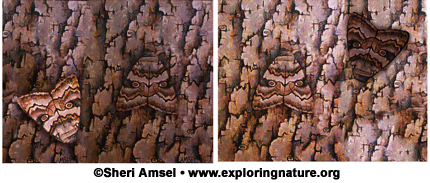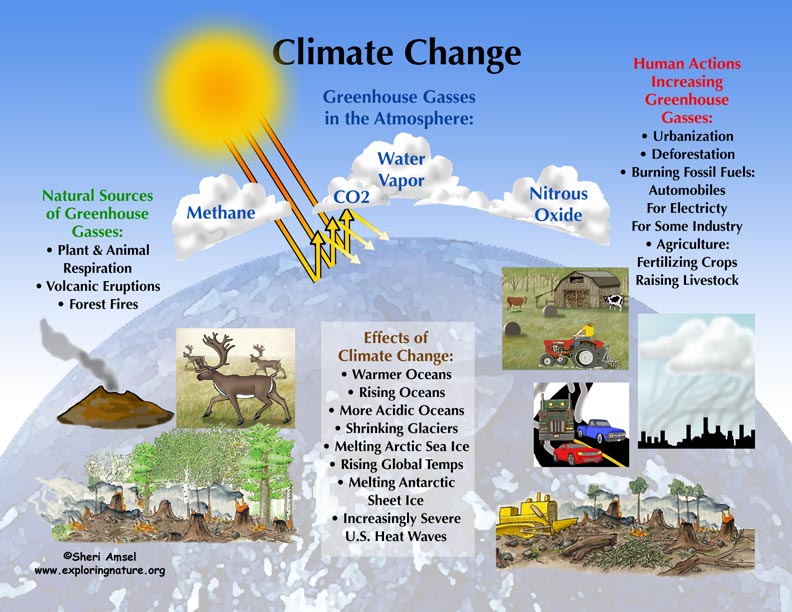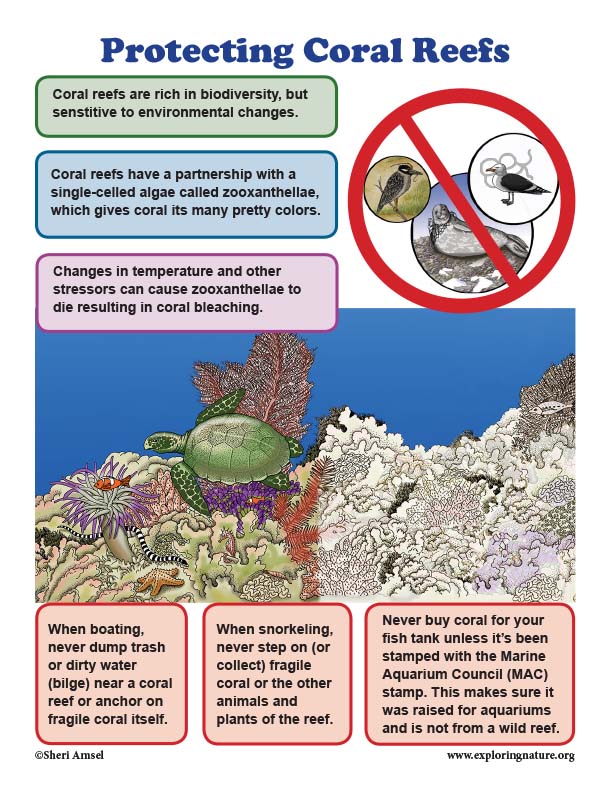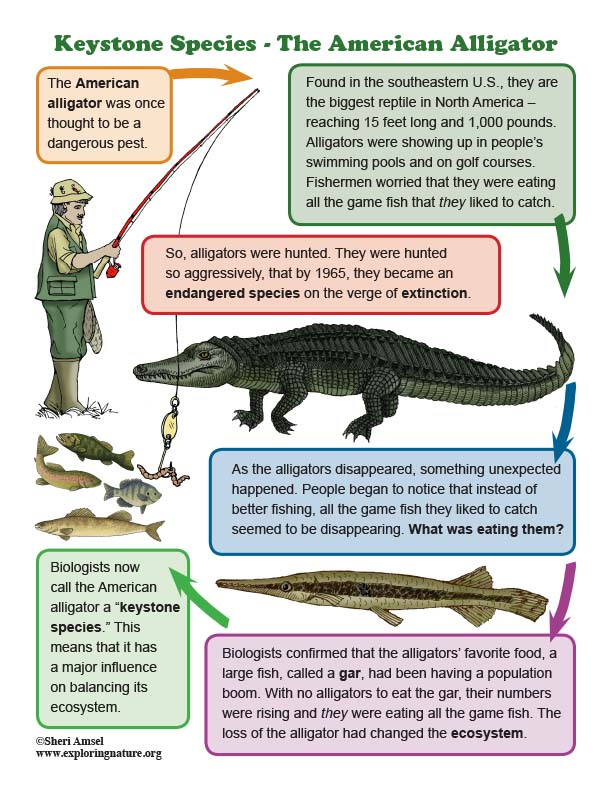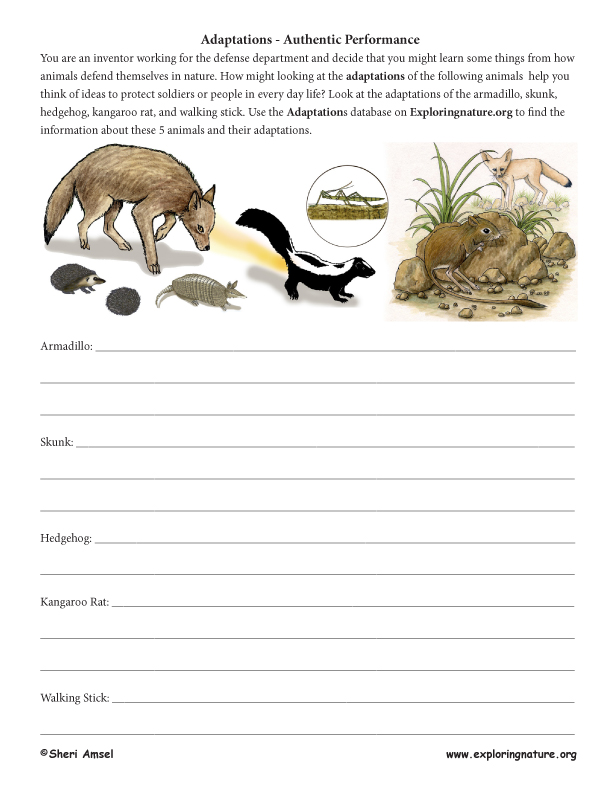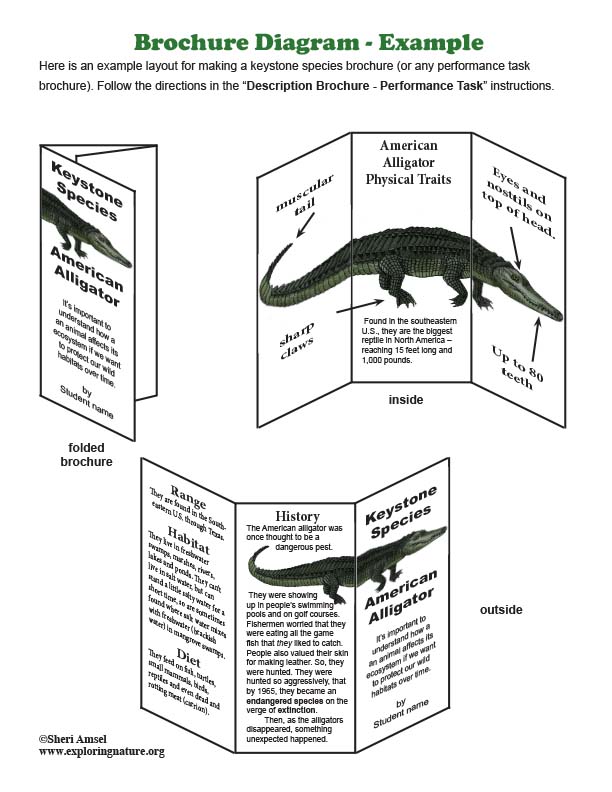

_________________________________________________________________________________________________________________________________________________________
NGSS Disciplinary Core Ideas
LS2.C: Ecosystem Dynamics, Functioning, and Resilience
• When the environment changes in ways that affect a place’s physical characteristics, temperature, or availability of resources, some organisms survive and reproduce, others move to new locations, yet others move into the transformed environment, and some die. (secondary to 3-LS4-4)
LS4.A: Evidence of Common Ancestry and Diversity
• Some kinds of plants and animals that once lived on Earth are no longer found anywhere. (Note: moved from K-2) (3-LS4-1)
• Fossils provide evidence about the types of organisms that lived long ago and also about the nature of their environments. (3-LS4-1)
LS4.B: Natural Selection
• Sometimes the differences in characteristics between individuals of the same species provide advantages in surviving, finding mates, and reproducing. (3-LS4-2)
LS4.C: Adaptation
• For any particular environment, some kinds of organisms survive well, some survive less well, and some cannot survive at all. (3-LS4-3)
LS4.D: Biodiversity and Humans
• Populations live in a variety of habitats, and change in those habitats affects the organisms living there. (3-LS4-4)
Performance Expectations Students who demonstrate understanding can:
3-LS4-1. Analyze and interpret data from fossils to provide evidence of the organisms and the environments in which they lived long ago.
3-LS4-2. Use evidence to construct an explanation for how the variations in characteristics among individuals of the same species may provide advantages in surviving, finding mates, and reproducing.
3-LS4-3. Construct an argument with evidence that in a particular habitat some organisms can survive well, some survive less well, and some cannot survive at all.
3-LS4-4. Make a claim about the merit of a solution to a problem caused when the environment changes and the types of plants and animals that live there may change.*
_________________________________________________________________________________________________________________________________________________________
Use the Template and Resource Links to Fulfill NGSS
l. Goals:
Essential Questions:
NGSS Note: Think, question, entertain ideas.
ll. Introductory Activities to Assess Prior Knowledge
A. Simple Activities - that assess students’ understanding.
• Adaptation Matching - Activity
• Adaptation to Your Environment - Matching
• Changing Ecosystems - Matching
• How Animals Survive the Winter - Matching (Color) or Adaptation Behavior for Winter Survival
• What Do I Eat? Match the Animal to its Food Activity
• Animal Diet Matching
• Animal Habitat Matching
• Animal Home Matching
• Helping Baby Survive Matching
• Winter Adaptations Activity
• How Animals Survive the Winter – Matching
• Animal Adaptation Observation and Critical Thinking
Our Fragile Coral Reefs - Vocabulary Cut and Paste
Biodiversity and Humans - Matching
Forest Fires and Animal Populations - Matching
Effects of Forest Fires - Vocabulary Cut and Paste
B. Brainstorming Session
Question: What does an animal need to stay alive, find a mate and reproduce in its environment?
1. Break students down into groups of 3-4.
2. Ask students to generate a list of what a specific animal (each group can choose their own or you can choose an animal and habitat in which it lives, i.e. lion on the African Savannah) needs to stay alive, find a mate and reproduce in its environment.
3. Discuss
lll. New Knowledge - Text
Read about how environmental changes can affect the animals that live there.
Read about Keystone Species – species that affect their environment in a significant way:
Read about:
Adaptation and Natural Selection
Ecosystem Dynamics, Functioning, and Resilience
Adaptation to their Environment - Diagram
Natural Selection in Caribou - Diagram
Keystone Species - American Alligator - Ecosystem Dynamics, Functioning, and Resilience
Sea Otters
Sharks
African Elephants
American Alligators
Keystone Species - The American Alligator - Mini-Poster
Read about Environmental Destruction:
Habitat Loss Generally
Panda and Habitat Loss
Coral Reefs Ecosystem Dynamics, Functioning, and Resilience
Coral Reefs and Environmental Changes
Protecting Coral Reefs - Mini-Poster
Read about Natural Selection and how it affects species survival and reproduction:
Adaptation Illustrated
Examples of different animal adaptations
Adaptation in the Schoolyard - Read and React
Read about Biodiversity and Extinction:
How Animals Go Extinct
Which Animals Have Gone Extinct?
Why is Biodiversity Important?
Examples of Models (depicts the concept expressed in the reading):
Ask students to look at the models and explain how each illustrates the concept.
Environmental change and potential impact on organisms:
Acid Rain Model
Climate Change (scroll down)
Ocean Pollution, More About Ocean Pollution
Forest Fires - Ecosystem Dynamics, Functioning, and Resilience
Look at the Model below as a visual aid for comprehension of the process of how environmental change can impact organisms:
Assessment:
Adaptive Traits - Critical Thinking Activity
Adaptive Traits in Insects - Matching
Adaptation and Natural Selection - Multiple Choice
Adaptation and Natural Selection - Short Answer Quiz
Ecosystem Dynamics, Functioning, and Resilience Short Answer Quiz
Ecosystem Dynamics, Functioning, and Resilience - Multiple Choice (Environmental Issues)
Global Warming and Climate Change - Multiple Choice
Other Ecology Testing
Seed Dispersal Adaptation - Comic Relief Activity
Acid Rain - Comic Relief Activity
lV. Experiments, Activities, Model-making (Critical Thinking)
Inquiry related to Environmental Change, Adaptation, Natural Selection:
Animal Inquiry - Live Studies in the Schoolyard
Pollination and Seed Dispersal Adaptations
Does Camouflage Protect Animals from Predation? Activity
Seed Dispersal - An Investigation
Photosynthesis - A Simple Experiment
What Grows Here? Inquiry-based Plant Activity
Acid Rain Inquiry (Understanding pH)
Adaptive Traits - Critical Thinking Activity
Adaptive Traits in Insects - Critical Thinking Activity
Keystone Species Descriptive Brochure - Performance Task
Protecting Coral Reefs - Poster Making
Authentic Performance - Understanding by Design (UbD) assessment tool.
Adaptations - Authentic Performance
Seed Dispersal Adaptation - Authentic Performance
Food Webs - Authentic Performance Activity
Use critical thinking to complete this Authentic Performance Activity and deepen understanding about adaptations and natural selection.
V. Summarize Knowledge - Enduring Understandings
Disciplinary Core Ideas
LS2.C: Ecosystem Dynamics, Functioning, and Resilience
• When the environment changes in ways that affect a place’s physical characteristics, temperature, or availability of resources, some organisms survive and reproduce, others move to new locations, yet others move into the transformed environment, and some die. (secondary to 3-LS4-4)
LS4.A: Evidence of Common Ancestry and Diversity
• Some kinds of plants and animals that once lived on Earth are no longer found anywhere. (Note: moved from K-2) (3-LS4-1)
• Fossils provide evidence about the types of organisms that lived long ago and also about the nature of their environments. (3-LS4-1)
LS4.B: Natural Selection
• Sometimes the differences in characteristics between individuals of the same species provide advantages in surviving, finding mates, and reproducing. (3-LS4-2)
LS4.C: Adaptation
• For any particular environment, some kinds of organisms survive well, some survive less well, and some cannot survive at all. (3-LS4-3)
LS4.D: Biodiversity and Humans
• Populations live in a variety of habitats, and change in those habitats affects the organisms living there. (3-LS4-4)
Analyzing and Interpreting Data
Analyzing data in 3–5 builds on K–2 experiences and progresses to introducing quantitative approaches to collecting data and conducting multiple trials of qualitative observations. When possible and feasible, digital tools should be used.
• Analyze and interpret data to make sense of phenomena using logical reasoning. (3-LS4-1)
Constructing Explanations and Designing Solutions
Constructing explanations and designing solutions in 3–5 builds on K–2 experiences and progresses to the use of evidence in constructing explanations that specify variables that describe and predict phenomena and in designing multiple solutions to design problems.
• Use evidence (e.g., observations, patterns) to construct an explanation. (3-LS4-2)
Engaging in Argument from Evidence
Engaging in argument from evidence in 3–5 builds on K–2 experiences and progresses to critiquing the scientific explanations or solutions proposed by peers by citing relevant evidence about the natural and designed world(s).
• Construct an argument with evidence. (3-LS4-3)
• Make a claim about the merit of a solution to a problem by citing relevant evidence about how it meets the criteria and constraints of the problem. (3-LS4-4)
Crosscutting Concepts (NGSS)
Cause and Effect
• Cause and effect relationships are routinely identified and used to explain change. (3-LS4-2),(3-LS4-3)
Scale, Proportion, and Quantity
• Observable phenomena exist from very short to very long time periods. (3-LS4-1)
Systems and System Models
• A system can be described in terms of its components and their interactions. (3-LS4-4)
Connections to Engineering, Technology, and Applications of Science
Interdependence of Engineering, Technology, and Science on Society and the Natural World
• Knowledge of relevant scientific concepts and research findings is important in engineering. (3-LS4-4)
Connections to Nature of Science
Scientific Knowledge Assumes an Order and Consistency in Natural Systems
• Science assumes consistent patterns in natural systems. (3-LS4-1)
Performance Expectations
Students who demonstrate understanding can:
3-LS4-1. Analyze and interpret data from fossils to provide evidence of the organisms and the environments in which they lived long ago. [Clarification Statement: Examples of data could include type, size, and distributions of fossil organisms. Examples of fossils and environments could include marine fossils found on dry land, tropical plant fossils found in Arctic areas, and fossils of extinct organisms.] [Assessment Boundary: Assessment does not include identification of specific fossils or present plants and animals. Assessment is limited to major fossil types and relative ages.]
3-LS4-2. Use evidence to construct an explanation for how the variations in characteristics among individuals of the same species may provide advantages in surviving, finding mates, and reproducing. [Clarification Statement: Examples of cause and effect relationships could be plants that have larger thorns than other plants may be less likely to be eaten by predators; and, animals that have better camouflage coloration than other animals may be more likely to survive and therefore more likely to leave offspring.]
3-LS4-3. Construct an argument with evidence that in a particular habitat some organisms can survive well, some survive less well, and some cannot survive at all. [Clarification Statement: Examples of evidence could include needs and characteristics of the organisms and habitats involved. The organisms and their habitat make up a system in which the parts depend on each other.]
3-LS4-4. Make a claim about the merit of a solution to a problem caused when the environment changes and the types of plants and animals that live there may change.* [Clarification Statement: Examples of environmental changes could include changes in land characteristics, water distribution, temperature, food, and other organisms.] [Assessment Boundary: Assessment is limited to a single environmental change. Assessment does not include the greenhouse effect or climate change.]
Common Core State Standards Connections
ELA/Literacy
RI.3.1 Ask and answer questions to demonstrate understanding of a text, referring explicitly to the text as the basis for the answers. (3-LS4-1),(3-LS4-2),(3-LS4-3),(3-LS4-4)
RI.3.2 Determine the main idea of a text; recount the key details and explain how they support the main idea. (3-LS4-1),(3-LS4-2),(3-LS4-3),(3-LS4-4)
RI.3.3 Describe the relationship between a series of historical events, scientific ideas or concepts, or steps in technical procedures in a text, using language that pertains to time, sequence, and cause/effect. (3-LS4-1),(3-LS4-2),(3-LS4-3),(3-LS4-4)
W.3.1 Write opinion pieces on topics or texts, supporting a point of view with reasons. (3-LS4-1),(3-LS4-3),(3-LS4-4)
W.3.2 Write informative/explanatory texts to examine a topic and convey ideas and information clearly. (3-LS4-1),(3-LS4-2),(3-LS4-3),(3-LS4-4)
W.3.8 Recall information from experiences or gather information from print and digital sources; take brief notes on sources and sort evidence into provided categories. (3-LS4-1)
SL.3.4 Report on a topic or text, tell a story, or recount an experience with appropriate facts and relevant, descriptive details, speaking clearly at an understandable pace. (3-LS4-2),(3-LS4-3),(3-LS4-4)
Mathematics
MP.2 Reason abstractly and quantitatively. (3-LS4-1),(3-LS4-2),(3-LS4-3),(3-LS4-4)
MP.4 Model with mathematics. (3-LS4-1),(3-LS4-2),(3-LS4-3),(3-LS4-4)
MP.5 Use appropriate tools strategically. (3-LS4-1)
3.MD.B.3 Draw a scaled picture graph and a scaled bar graph to represent a data set with several categories. Solve one- and two-step “how many more” and “how many less” problems using information presented in scaled bar graphs. (3-LS4-2),(3-LS4-3)
3.MD.B.4 Generate measurement data by measuring lengths using rulers marked with halves and fourths of an inch. Show the data by making a line plot, where the horizontal scale is marked off in appropriate units—whole numbers, halves, or quarters. (3-LS4-1)
When you research information you must cite the reference. Citing for websites is different from citing from books, magazines and periodicals. The style of citing shown here is from the MLA Style Citations (Modern Language Association).
When citing a WEBSITE the general format is as follows.
Author Last Name, First Name(s). "Title: Subtitle of Part of Web Page, if appropriate." Title: Subtitle: Section of Page if appropriate. Sponsoring/Publishing Agency, If Given. Additional significant descriptive information. Date of Electronic Publication or other Date, such as Last Updated. Day Month Year of access < URL >.
Amsel, Sheri. "Grade 3 - 3-LS4 Biological Evolution: Unity and Diversity" Exploring Nature Educational Resource ©2005-2024. December 13, 2024
< http://www.exploringnature.org/db/view/Grade-3-3-LS4-Biological-Evolution-Unity-and-Diversity >
